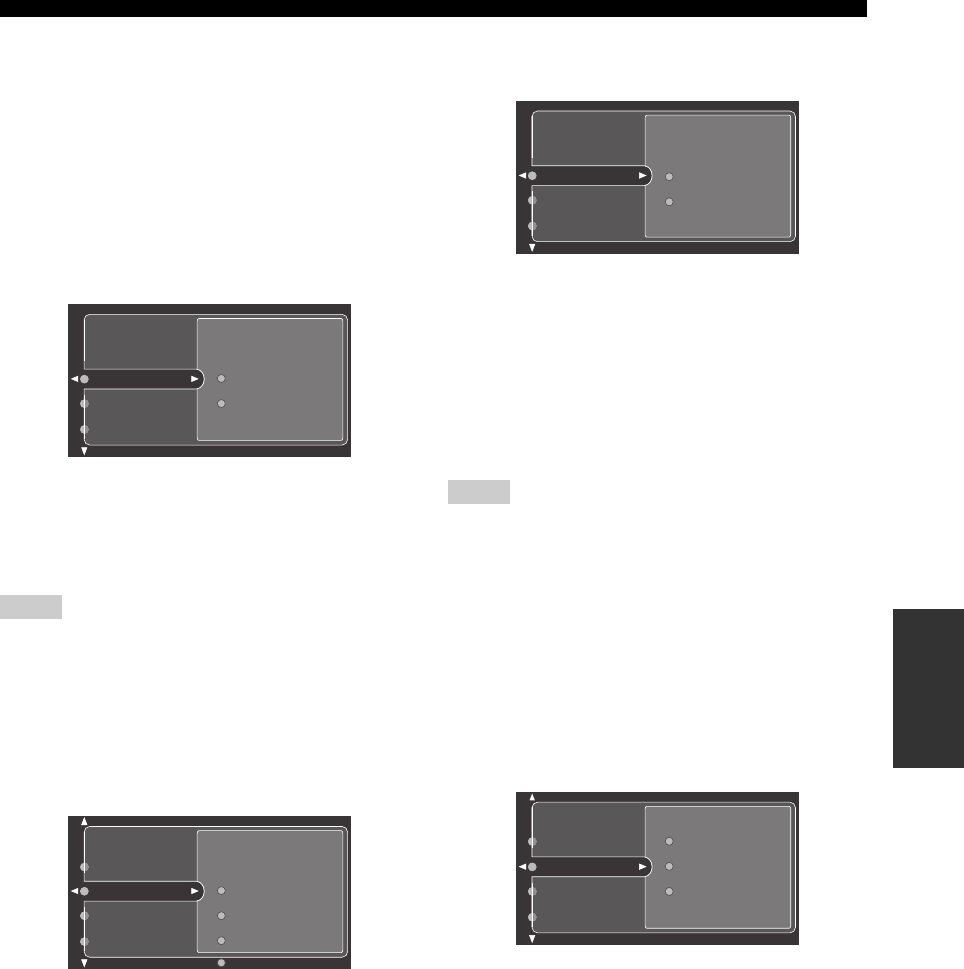
105 En
GRAPHIC USER INTERFACE (GUI) SCREEN
ADVANCED
OPERATION
y
• Most of the parameters described in the basic menu are set
automatically when you run “Auto Setup”. You can use the
basic menu to make further adjustments, but we recommend
running “Auto Setup” first.
• You can reset these parameters by performing the “Auto Setup”
procedure (see page 35).
■ Test Tone (Test tone)
Turns the test tone output on or off for “Speaker Set”,
“Speaker Distance” and “Speaker Level” settings.
Choices: Off, On
y
If you use a handheld sound pressure level meter, hold at arm’s
length and point upwards so that the meter is in the listening
position. With the meter set to the 70 dB scale and to C SLOW,
calibrate each speaker to 75 dB.
• Loud test tones will be output when “On” is selected. In this
case, make sure no children are present in the listening room.
• If you select “On” and enter the “Speaker Set”, “Speaker Level”
or “Speaker Distance” menu, the test tone is output from the
selected speakers.
■ Speaker Set (Speaker settings)
Use to manually adjust any speaker setting.
y
• If you are not satisfied with the bass sounds from your speakers,
you can change these settings according to your preference.
• When the diameter of the woofer section of the speaker unit is
larger than 16 cm (6.5 in), set the correspondent speaker setting
parameter to “Large”.
Front (Front speakers)
Choices: Large, Small
• Select “Large” (large) if you have large front speakers
that reproduce low-frequency signals effectively. All
the front left and right channel signals are directed to
the front left and right speakers.
• Select “Small” (small) if you have small front speakers
that do not reproduce low-frequency signals
effectively. The low-frequency signals of the front left
and right channels are directed to the speakers selected
in “Bass Out” (see page 107).
• When “Bass Out” is set to “Front” (see page 107), the LFE
signals found in Dolby Digital or DTS sources, the low-
frequency signals of the front left and right channels, and the
low-frequency signals of other speakers set to “Small” are all
directed to the front left and right speakers regardless of the
“FRONT SP” setting.
• When “Bass Out” is set to “Front” (see page 107), you can
select only “Large” in “Front”. If the value of “Front” is set to
other than “Large” in advance, this unit change the value to
“Large” automatically.
Center (Center speaker)
Choices: Large, Small, None
• Select “Large” (large) if you have a large center
speaker that reproduces low-frequency signals
effectively. All the center channel signals are directed
to the center speaker.
• Select “Small” (small) if you have a small center
speaker that does not reproduce low-frequency signals
effectively. The low-frequency signals of the center
channel are directed to the speakers selected in “Bass
Out”.
• Select “None” (none) if you did not connect a center
speaker. The center channel signals are directed to the
front left and right speakers.
Notes
Off
On
Speaker Set
Speaker Distance
Test Tone
Front
Surround
Center
Speaker Distance
Speaker Level
Test Tone
Speaker Set
Notes
Large
Small
Center
Surround
Front
Large
Small
NoneSurround
Surround Back
Center
Front


















